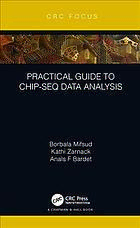
Practical guide to ChIP-seq: data analysis PDF
Preview Practical guide to ChIP-seq: data analysis
Practical Guide to ChIP-seq Data Analysis Focus Computational Biology Series This series aims to capture new developments in computational biology and bioinformatics in concise form. It seeks to encourage the rapid and wide dissemination of material for emerging topics and areas that are evolving quickly. The titles included in the series are meant to appeal to students, researchers, and professionals involved in the field. The inclusion of concrete examples and applications, and programming techniques and examples, is highly encouraged. Systems-Level Understanding of Microbial Communities Theory and Practice Aarthi Ravikrishnan and Karthik Raman Practical Guide to ChIP-seq Data Analysis Borbala Mifsud, Kathi Zarnack, Anaïs F Bardet Practical Guide to ChIP-seq Data Analysis Borbala Mifsud Kathi Zarnack Anaïs F Bardet CRC Press Taylor & Francis Group 6000 Broken Sound Parkway NW, Suite 300 Boca Raton, FL 33487-2742 © 2019 by Taylor & Francis Group, LLC CRC Press is an imprint of Taylor & Francis Group, an Informa business No claim to original U.S. Government works Printed on acid-free paper Version Date: 20181008 International Standard Book Number-13: 978-1-138-59652-8 (Hardback) This book contains information obtained from authentic and highly regarded sources. Reasonable efforts have been made to publish reliable data and information, but the author and publisher cannot assume responsibility for the validity of all materials or the consequences of their use. The authors and publishers have attempted to trace the copyright holders of all material reproduced in this publication and apologize to copyright holders if permission to publish in this form has not been obtained. If any copyright material has not been acknowledged please write and let us know so we may rectify in any future reprint. Except as permitted under U.S. Copyright Law, no part of this book may be reprinted, reproduced, transmitted, or utilized in any form by any electronic, mechanical, or other means, now known or hereafter invented, including photocopying, microfilming, and recording, or in any information storage or retrieval system, without written permission from the publishers. For permission to photocopy or use material electronically from this work, please access www.copyright.com (http://www.copyright.com/) or contact the Copyright Clearance Center, Inc. (CCC), 222 Rosewood Drive, Danvers, MA 01923, 978-750-8400. CCC is a not-for-profit organization that provides licenses and registration for a variety of users. For organizations that have been granted a photocopy license by the CCC, a separate system of payment has been arranged. Trademark Notice: Product or corporate names may be trademarks or registered trademarks, and are used only for identification and explanation without intent to infringe. Visit the Taylor & Francis Web site at http://www.taylorandfrancis.com and the CRC Press Web site at http://www.crcpress.com Preface Over the past decade, the experimental ChIP-seq protocol as well as the associatedcomputationalanalysismethods evolvedrapidly. Researchersfaceaplethoraofpossibleexperimentalandanalytical ChIP-seq approaches, and the lack of a single perfect recipe can make use of the protocol daunting from the start. Each ChIP-seq experiment needs to be tailored to the protein or modification of interest, to the studied organism and to the biological question. Our aim is to summarise the points that need to be considered when performing such a study in order to obtain high-quality and interpretable data. In this book, we will discuss the importance of experimental and analytical choices and give advice for different scenarios.In particular,we willguide the readerthroughthe com- putational analysis steps from initial quality controlthroughpeak calling to downstream analyses and visualisation. This book will thereby show a full workflow,with alternative paths that aresuit- able for researchers with diverse bioinformatics experience, using Unix command line and R-based solutions. We hope that this book will help experimental biologists to design their ChIP-seq experiments with the analysis in mind, and to perform the first analysis steps themselves; moreover, it will supportbioinformaticianstounderstandhowthedataisgenerated, what the sources of biases are and which methods are appropriate for the different analysis steps. v Authors Borbala Mifsud obtained a PhD in molecular biology at the Institute of MolecularPathology(IMP)in Vienna, Austria.In the laboratory of Thomas Jenuwein, she worked on epigenetic profil- ing of a histone methyltrasferase mutant mouse, using ChIP-seq. In 2010, she started her postdoctoral work at the EMBL Euro- pean Bioinformatics Institute (EBI) in the laboratory of Nicholas Luscombe. She is currently an assistant professor at Hamad Bin Khalifa University, Doha, Qatar and honorary lecturer at Queen Mary University London, UK, working on 3D chromatin confor- mation and the integration of epigenomic data. KathiZarnackearnedaPhDinmolecularbiologyattheMax- Planck Institute for Terrestrial Microbiology in Marburg, Ger- many, working on the impact of posttranslational modifications on transcriptionfactor specificity. Moving into bioinformatics, she thenjoinedtheEMBLEuropeanBioinformaticsInstitute(EBI)in Hinxton,UK,asapostdoctoralresearcherinthegroupofNicholas Luscombe. Since 2014, she leads a research group on Computa- tional RNA Biology at the Buchmann Institute for Molecular Life Sciences (BMLS), Goethe University Frankfurt, Germany. Ana¨ıs F. Bardet completed a PhD in computational biology in the laboratoryof Alexander Stark at the Institute of Molecular Pathology(IMP)inVienna,Austria.She studiedthe conservation of transcriptionfactor binding sites in different Drosophila species and developed tools and pipelines for the comparative analysis of ChIP-seq data. She then worked as a postdoctoral researcher in the laboratory of Dirk Schu¨beler at the Friedrich Miescher Insti- tute for Biomedical Research (FMI) in Basel, Switzerland, where she investigated the sensitivity of transcription factors to DNA methylation. Since 2017, she is a tenured researcher at the Na- tional Center for Scientific Research (CNRS) at the University of Strasbourg,France,whereshe developsprojectsexploringthe reg- ulation of transcription factor binding. vii Contents Chapter 1(cid:4) Introduction to ChIP-seq 1 BorbalaMifsud 1.1 CHIP-SEQEXPERIMENT 1 1.2 IMPROVEDDETECTIONPROTOCOLS 4 1.2.1 ChIP-exo 4 1.2.2 ChIP-nexus 4 1.2.3 CUT&RUN 4 1.2.4 DamID 5 1.3 CHIP-SEQDATAANALYSISWORKFLOW 5 1.4 DESIGNINGACHIP-SEQEXPERIMENT 6 1.4.1 ChIP-seq controls 6 1.4.2 Sources of bias 6 1.4.3 Antibody quality 7 1.4.4 Read depth 8 1.4.5 Read properties 8 1.4.6 Replicates 9 Chapter 2(cid:4) Getting Started 11 Ana¨ısBardet 2.1 CHIP-SEQDATASETS 11 2.2 COMPUTATIONALREQUIREMENTS 13 2.2.1 Computing environment 13 2.2.2 Data 13 2.2.3 Software 14 2.2.4 File formats 15 2.3 DATARETRIEVALFROMGEO 15 ix
